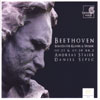Beethoven Violin Sonatas Nos 4 & 7
Beethoven’s own violin and Beethoven-style vigour – all highly entertaining
View record and artist detailsRecord and Artist Details
Composer or Director: Ludwig van Beethoven
Genre:
Chamber
Label: Harmonia Mundi
Magazine Review Date: 10/2006
Media Format: CD or Download
Media Runtime: 55
Mastering:
Stereo
DDD
Catalogue Number: HMC90 1919

Tracks:
| Composition | Artist Credit |
|---|---|
| Sonata for Violin and Piano No. 4 |
Ludwig van Beethoven, Composer
Andreas Staier, Piano Daniel Sepec, Violin Ludwig van Beethoven, Composer |
| Sonata for Violin and Piano No. 7 |
Ludwig van Beethoven, Composer
Andreas Staier, Piano Daniel Sepec, Violin Ludwig van Beethoven, Composer |
| Variations on 'Se vuol ballare' from Mozart's 'Le nozze di Figaro' |
Ludwig van Beethoven, Composer
Andreas Staier, Piano Daniel Sepec, Violin Ludwig van Beethoven, Composer |
Author: DuncanDruce
The novel feature here is that Daniel Sepec’s violin is one of a set presented
to Beethoven in 1800 by Prince Lichnowsky. Made in Salzburg around 1700 and restored to its original condition, its whereabouts were unknown until 10 years ago, when it was presented to the Beethoven-Haus in Bonn. In Sepec’s hands it has a sweet, expressive tone, an important element in these remarkably imaginative, stimulating performances. Andreas Staier plays
a Graf pianoforte from the 1820s, of a type Beethoven was familiar with, though not at the time he wrote these sonatas. But if it has a smoother sound and wider dynamic range than earlier instruments, it’s still able to present Beethoven’s keyboard textures with perfect clarity. Staier’s enthusiastic approach occasionally swamps the violin – but one can easily imagine the young Beethoven doing the same.
Staier and Sepec take us a long way beyond the concept of historically informed playing as simply avoiding anachronism. In the first movement of Sonata No 7, Sepec introduces expressive portamenti, as well as the kind of rubato where he momentarily lags behind the piano’s rhythm. In the following Adagio, Staier makes highly expressive use of spread chords, and throughout the CD there are instances of subtle tempo variation and added dynamics, for example the beautiful shaping of the main theme in No 4’s second movement. In the Variations, Staier makes full use of the Graf’s range of sonorities, including a remarkable percussive surprise! Yet these ‘authentic’ features all stem from a clear view of the music’s expressive qualities and result in performances of unusual verve and spontaneity.
Staier and Sepec take us a long way beyond the concept of historically informed playing as simply avoiding anachronism. In the first movement of Sonata No 7, Sepec introduces expressive portamenti, as well as the kind of rubato where he momentarily lags behind the piano’s rhythm. In the following Adagio, Staier makes highly expressive use of spread chords, and throughout the CD there are instances of subtle tempo variation and added dynamics, for example the beautiful shaping of the main theme in No 4’s second movement. In the Variations, Staier makes full use of the Graf’s range of sonorities, including a remarkable percussive surprise! Yet these ‘authentic’ features all stem from a clear view of the music’s expressive qualities and result in performances of unusual verve and spontaneity.
Discover the world's largest classical music catalogue with Presto Music.

Gramophone Digital Club
- Digital Edition
- Digital Archive
- Reviews Database
- Full website access
From £8.75 / month
Subscribe
Gramophone Full Club
- Print Edition
- Digital Edition
- Digital Archive
- Reviews Database
- Full website access
From £11.00 / month
Subscribe
If you are a library, university or other organisation that would be interested in an institutional subscription to Gramophone please click here for further information.




